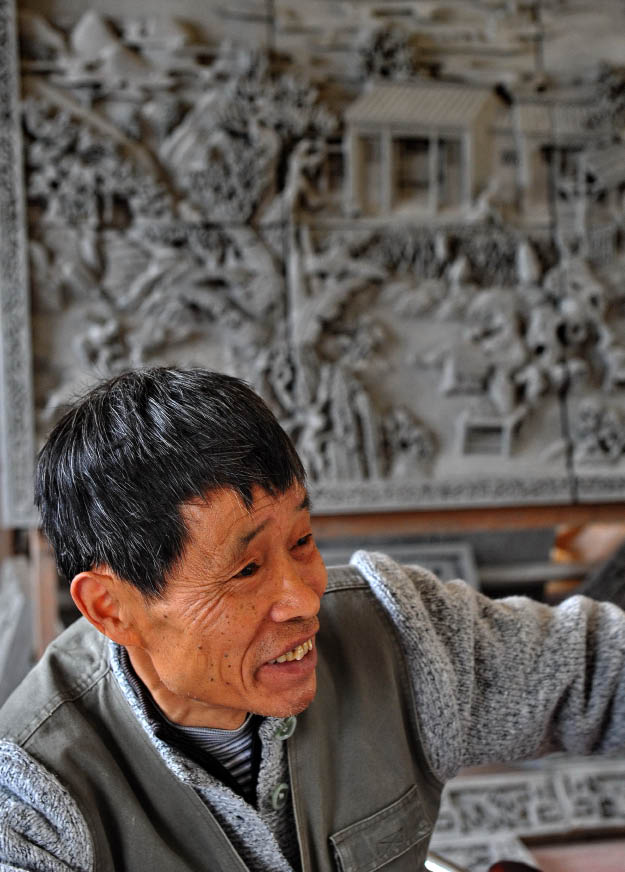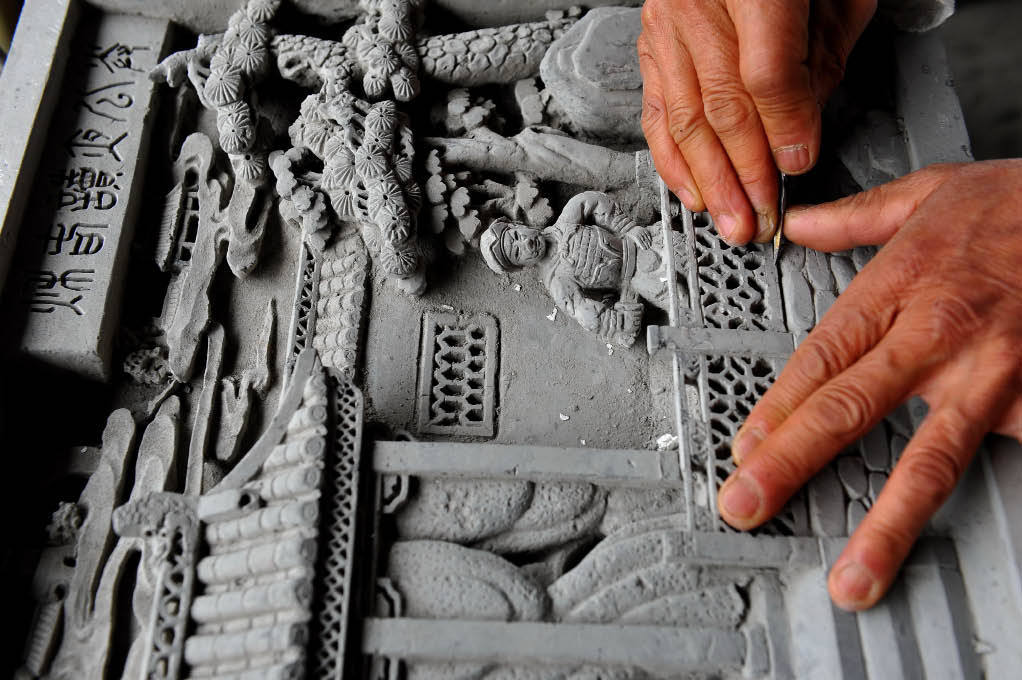Fang Xinzhong: Inheritor of Huizhou Brick Carving
By staff reporter JIAO FENG
 People Profile:
People Profile:
Fang Xinzhong was born in Shanghai in 1949 but he spent his formative years in the countryside of Shexian County, Huangshan City in Anhui Province, where he taught himself traditional wood and bamboo carving. At the age of 36, he joined the Shexian Huizhou Classical Landscape Architecture Company, and embarked on a career in brick carving. Over three decades, Fang inherited and developed the traditional techniques of Huizhou-style brick carving, participating in projects for the Jingjue Temple, Li Xiangjun Former Residence Museum, and the President Palace in Nanjing. His talents were recognized abroad, too: He was commissioned to create all the brick carvings for the Chunhua Garden, a Huizhou-style construction in Frankfurt. In 2007 he was entered into China’s first list of inheritors of Intangible Cultural Heritage.
HUANGSHAN City, in Southern Anhui Province, was the seat of ancient Huizhou, a major cultural and economic hub in history. In the ancient villages scattering this hilly area, time seems to have stood still. Walking down the narrow streets, the Huizhou-style residences on both sides take travelers back hundreds of years. People usually stop to examine the fabulous carvings on the arches. Brick carving is one of main characteristics of Huizhou-style constructions and an integral part of Huizhou architecture.
Using the local gray brick, the carvings were widely used in arches, doorframes, lintels, eaves, roofs, and pillar bases to make the construction more elegant and dignified. When I met Fang Xinzhong, he was helping his students. Dressed in blue work clothes, he dusted himself off, invited me into his office and told his story from the start.
Unexpected Turn of Events
Fang was born in October 1949, when the People’s Republic of China was established, so he was named “Xinzhong,” which means New China. His grandfather Fang Yuyan was a famous educator and had been a member of the Third and Fourth National Committee of the Chinese People's Political Consultative Conference (CPPCC).
Had the cultural revolution never happened, Fang’s life might have taken a different path: study in Shanghai, work, marriage, family. But “what if?” is never easy to answer, and sometimes the how and why of history can only be put down to “destiny.”
After finishing the first year of middle school, Fang moved to Shexian of Anhui Province with his mother. Fang recalled some fragments of his childhood: his grandfather's influence, his parents’ jobs as teachers in Shanghai, and their house, just next to that of Madame Soong Ching Ling. Coming from a big city, Fang couldn’t get used to the countryside, and was resigned to the fact. Fortunately, he had his love of painting to brighten his mood. After a day’s farming, Fang would draw pictures on the walls of his own house and even those of neighbors, or make color clay sculptures. “At that time I was always looking for a way out,” Fang said. “Later, I realized that my path had been there all along, right under my nose.”
One day, he came across some exquisite carvings on a house and was immediately drawn to them. Fang tried to carve something on bamboo, the cheapest material he could find.
There were many local carving masters, but Fang had no time or the funds to study. If he had spare time, he would search for well-kept engravings, examining the ancient carvings and replicating them at home. Art is a talent, and in the face of adversity, it is said talent will burst into extraordinary creativity. With persistent efforts, Fang mastered all kinds of carving techniques.
Specialist in Brick Carving
|
 |
|
Hui-style brick carving of local gray bricks known for their solidness and smoothness. photos by Yu Xiangjun |
The year 1985 saw another turn of events for Fang. That year, the Huizhou Classical Landscape Architecture Company was recruiting carvers. Fang, though at 36 years old had exceeded the maximum recruiting age, went for an interview and took a portfolio of his wood and bamboo carvings. He was admitted for his superior skills.
The newly-established company had gathered a group of apprentices, most of whom were carpenters, stonemasons and bricklayers. With no practical experience, Fang had to study brick carving, a relatively unpopular profession. “There was no brick carver in the company,” he recalled, “I didn’t really know what brick carving was.”
Brick carving was mostly used to embellish ancient constructions but with the rise of modern architecture it gradually disappeared. Some old craftsmen had mastered the traditional skills, and Fang’s task was to seek them out and learn from them.
While working at the company, Fang built a relationship with many carvers and learned a lot from them. “I have no master; everyone is my teacher,” he said. “I learned from anyone who knew more than me, so everyone liked to talk with me, and they all helped my career a great deal.”
Not long after he had started working in the company, Fang was given a fantastic opportunity. The company was commissioned to restore the brick arch of the Jingjue Temple in Nanjing. Fang says this arch officially started his career. “At the beginning, it was so difficult – I didn’t even know what tools to use, or how to use them. I had to experiment.” Fang asked for help from senior craftsmen and also researched the patterns of old houses and studied the style of brick carving used in the original structure. The restoration project was a huge success, and Fang found great pleasure in it. “Now, I immerse myself in the maintenance of old constructions, and I love the profession even more,” he said. “The classical works made hundreds of years ago are still incredibly impressive.”
Soon Fang surpassed himself. He may not have been the most talented worker in the company, but he was the most diligent one.

